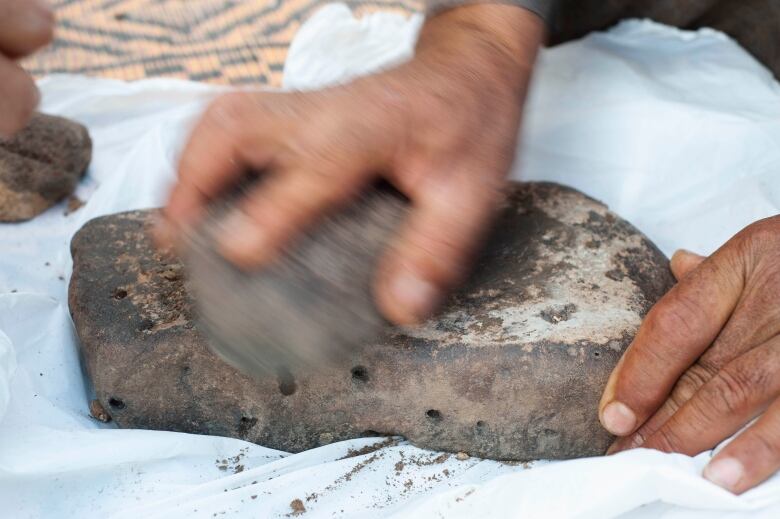A bread recipe from 14,000 years ago: wild oats, barley, wheat and roots

Hunter-gatherers baked flatbread 14,000 years ago, say archeologists who suspect it was a coveted luxury item that may have sparked the first agricultural innovations.
While bread is now a staple, it didn't start out that way.
This week, archeologists working in Jordan reported on the discovery of charred remains of flatbread.
It's the oldest direct evidence of bread found to date, said Canadian Monica Nicolaides Ramsey, a Marie Curie Fellow in archeology at the University of Cambridge, U.K., and one of the study's authors.
"People were making bread 4,000 years before they started farming, is what this find says," Nicolaides Ramsey said.
Until now, the oldest evidence of bread came from Turkey 9,000 years ago.
The hunter-gatherers
The hunter-gatherers who lived at the archeological site where the discovery was made are called Natufians. They lived right before the dawn of agriculture, when humans started to cultivate grain.
Natufians are known for living in complex stone structures, carving bones into artworks, meticulously-built hearths or fireplaces, and burying their dead with symbolism, said the study's first author, archaeobotanist Amaia Arranz Otaegui of the University of Copenhagen.

Unlike their ancestors who were more nomadic, the Natufians established more permanent and larger communities, the researchers said. The settlement the archeologists investigated in this study is in northeastern Jordan in the Black Desert.
Special hearth
The team found two buildings, each containing a large, circular stone fireplace. That's where they found charred bread remains resembling crumbs from the bottom of today's toasters.
I think that they were they were grinding it all down to this really fine flour, which would have been amazing at that time, a food revolution if you will.- Monica Nicolaides Ramsey
By analyzing the crumbs under the microscope, the researchers described its porous structures and identified the plant ingredients.
Since the archeological evidence suggests that Natufians also hunted gazelle and waterfowl, it's possible they used the bread for a mini-feast or even a sandwich, Nicolaides Ramsey speculated.
Recipe for success
The bread's ingredients included wild barley, wild wheat, wild oats and club rush tuber, an aquatic plant.
"If you're a hunter-gatherer you need to have reliable resources. You can't set up a community [and] build stone structures if you don't have a reliable source of food. So a wetland is a really important place. It's like the ancient grocery store," Nicolaides Ramsey said.
For example, roots are available year round at a wetland.
"The bigger surprise is that they were using cereals. Those are a little bit harder to find especially at that time period with the environment," added Nicolaides Ramsey from Cambridge's McDonald Institute for Archaeological Research.
Cereals only fruit for a short period, which makes them harder for people to gather.
"I think that they were grinding it all down to this really fine flour, which would have been amazing at that time, a food revolution if you will, and mixing it with water and then forming into some sort of a patty, maybe a flatbread."
'Culinary treat'
She said the flatbread was likely spread over a hot rock and baked in the hearth, similar to how pizza or naan are baked today.

Given all the effort that went into making bread and the fact so little was found, the flatbread was likely a luxury item, Nicolaides Ramsey said.
"It was a special culinary treat and maybe with time more people wanted it. Therefore it became more of a staple."
It could be that bread was such a desirable product that it was an incentive for people to take up agricultural cultivation of crops.
Next, the researchers hope to work with professional chefs to re-create the recipe.
So far, they've successfully ground the club rush tuber into flour. Arranz Otaegui said it tasted gritty with a sweet texture and a bit salty, perhaps from the water it was grown in.
"Not quite to our regular taste, but maybe that's why they also added the cereal to it," Nicolaides Ramsey said.